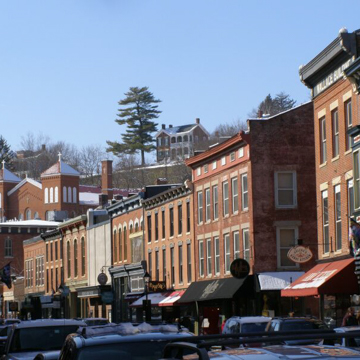Downtown Galena, located near the Mississippi River in the far northwestern corner of Illinois, developed in the first half of the nineteenth century to accommodate local lead mining and riverboat trade. Native Americans had traditionally collected lead sulfide from the hilly, non-glaciated region, and the French began mining the area by 1693. In 1821, American settlers established a permanent mining settlement on a hill along the Fever River (later renamed the Galena River), about five miles northeast of its confluence with the wide, flood-prone Mississippi. The next year, the federal government took over the operation of the nearby mines, initiating America’s first mineral rush.
In 1826, Lieutenant Martin Thomas platted the town, and residents christened it Galena, after the town’s lead sulfide raison d’être. By 1828, mining and smelting activities supported one of the largest towns in Illinois, and regular steamboat service connected Galena to other river towns from Minnesota to Louisiana. In 1845, Galena produced 80 percent of the nation’s lead. Thomas’s plan for Galena reconciles the orthogonal ideal with the hilly geography and the curving Galena River, resulting in a loosely gridded street plan, with a bend in most north-south streets, including Main Street, on which wood buildings were quickly erected to accommodate the needs of the rapidly growing town.
In 1845, the town built a two-story Market House, with space for twelve stalls on the ground floor, jail cells in the basement, and a city hall above. Occupying a full block, one block south of Main Street, the three-bay, brick, Greek Revival building is topped by an end gable roof and a modest tower. One-story additions to the north and south accommodated the fire company and the city clerk.
After downtown Galena suffered a major fire in 1854, the town created zoning restrictions against wood construction. Much of the seven-block urban core of Galena was built in the wake of that fire—two- to five-story buildings of mostly locally fired brick, with shopfronts at the ground floor, and offices and apartments above. Dentiled or bracketed lintels and cornices provide these simple brick buildings with the trappings of the Greek Revival or Italianate styles. The density and uniformity of these brick buildings, set along Main Street’s distinctive curve, contributed to the street’s nickname, “The Wall.”
The DeSoto House Hotel was among the most significant buildings constructed in the period. Opened in 1855, and located along Main Street, close to the midway point of the commercial zone, the five-story Italianate building accommodated 225 guest rooms, as well as social rooms, dining rooms, and a multistory central atrium. Cast-iron colonettes flank the entry, a cast-iron balcony lines the second floor Main Street facade, and decorative brackets support the cornice. Abraham Lincoln spoke from the balcony, and local son Ulysses S. Grant ran his presidential campaign out of the hotel. The DeSoto House Hotel closed in 1870, but reopened a year later. In 1880, the top two floors of the building were removed.
The Illinois Central reached Galena in 1854, as the railroad continued its gradual usurpation of water travel in the United States. Despite its rail link, as a riverboat town, Galena gradually shrank in both population and commercial importance. Market House closed in 1910, and city hall relocated in 1938, a year after a serious flood damaged buildings on Main Street. Flood walls built in 1951 altered some landscape features. Although the town gained recognition as the home of Grant and eight other Union generals, the lack of economic growth ensured that little changed on Main Street for nearly a century.
In 1965, Galena passed the state’s second historic preservation ordinance, and in 1968, the National Park Service established the Galena Historic District, which encompassed 85 percent of the town, including Main Street. In the 1980s, a preservation-minded mayor spearheaded the rehabilitation of the DeSoto House Hotel. The hotel reopened in 1986 after a major rehabilitation effort, and continues to operate as Illinois’s oldest hotel, with 55 guest rooms. The Market House, which the City of Galena deeded to the State of Illinois in 1947, now operates as a museum and visitors’ center for historically minded tourists that frequent the city. Main Street’s well-preserved commercial buildings continue to tell the story of early-nineteenth-century river towns of the Mississippi basin.
References
Kriviskey, Bruce, “Galena Historic District,” Jo Daviess County, Illinois. National Register of Historic Places Nomination Form, 1969. National Park Service, U.S. Department of the Interior, Washington, D.C.

